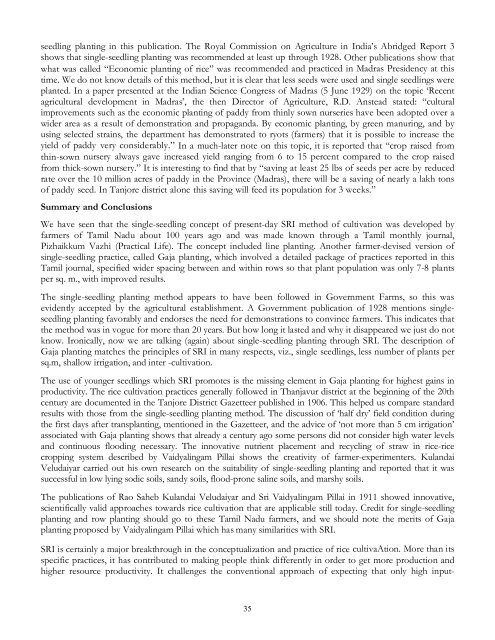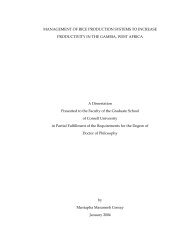Revised proceedings - The System of Rice Intensification - Cornell ...
Revised proceedings - The System of Rice Intensification - Cornell ...
Revised proceedings - The System of Rice Intensification - Cornell ...
Create successful ePaper yourself
Turn your PDF publications into a flip-book with our unique Google optimized e-Paper software.
seedling planting in this publication. <strong>The</strong> Royal Commission on Agriculture in India‟s Abridged Report 3<br />
shows that single-seedling planting was recommended at least up through 1928. Other publications show that<br />
what was called “Economic planting <strong>of</strong> rice” was recommended and practiced in Madras Presidency at this<br />
time. We do not know details <strong>of</strong> this method, but it is clear that less seeds were used and single seedlings were<br />
planted. In a paper presented at the Indian Science Congress <strong>of</strong> Madras (5 June 1929) on the topic „Recent<br />
agricultural development in Madras‟, the then Director <strong>of</strong> Agriculture, R.D. Anstead stated: “cultural<br />
improvements such as the economic planting <strong>of</strong> paddy from thinly sown nurseries have been adopted over a<br />
wider area as a result <strong>of</strong> demonstration and propaganda. By economic planting, by green manuring, and by<br />
using selected strains, the department has demonstrated to ryots (farmers) that it is possible to increase the<br />
yield <strong>of</strong> paddy very considerably.” In a much-later note on this topic, it is reported that “crop raised from<br />
thin-sown nursery always gave increased yield ranging from 6 to 15 percent compared to the crop raised<br />
from thick-sown nursery.” It is interesting to find that by “saving at least 25 lbs <strong>of</strong> seeds per acre by reduced<br />
rate over the 10 million acres <strong>of</strong> paddy in the Province (Madras), there will be a saving <strong>of</strong> nearly a lakh tons<br />
<strong>of</strong> paddy seed. In Tanjore district alone this saving will feed its population for 3 weeks.”<br />
Summary and Conclusions<br />
We have seen that the single-seedling concept <strong>of</strong> present-day SRI method <strong>of</strong> cultivation was developed by<br />
farmers <strong>of</strong> Tamil Nadu about 100 years ago and was made known through a Tamil monthly journal,<br />
Pizhaikkum Vazhi (Practical Life). <strong>The</strong> concept included line planting. Another farmer-devised version <strong>of</strong><br />
single-seedling practice, called Gaja planting, which involved a detailed package <strong>of</strong> practices reported in this<br />
Tamil journal, specified wider spacing between and within rows so that plant population was only 7-8 plants<br />
per sq. m., with improved results.<br />
<strong>The</strong> single-seedling planting method appears to have been followed in Government Farms, so this was<br />
evidently accepted by the agricultural establishment. A Government publication <strong>of</strong> 1928 mentions singleseedling<br />
planting favorably and endorses the need for demonstrations to convince farmers. This indicates that<br />
the method was in vogue for more than 20 years. But how long it lasted and why it disappeared we just do not<br />
know. Ironically, now we are talking (again) about single-seedling planting through SRI. <strong>The</strong> description <strong>of</strong><br />
Gaja planting matches the principles <strong>of</strong> SRI in many respects, viz., single seedlings, less number <strong>of</strong> plants per<br />
sq.m, shallow irrigation, and inter -cultivation.<br />
<strong>The</strong> use <strong>of</strong> younger seedlings which SRI promotes is the missing element in Gaja planting for highest gains in<br />
productivity. <strong>The</strong> rice cultivation practices generally followed in Thanjavur district at the beginning <strong>of</strong> the 20th<br />
century are documented in the Tanjore District Gazetteer published in 1906. This helped us compare standard<br />
results with those from the single-seedling planting method. <strong>The</strong> discussion <strong>of</strong> „half dry‟ field condition during<br />
the first days after transplanting, mentioned in the Gazetteer, and the advice <strong>of</strong> „not more than 5 cm irrigation‟<br />
associated with Gaja planting shows that already a century ago some persons did not consider high water levels<br />
and continuous flooding necessary. <strong>The</strong> innovative nutrient placement and recycling <strong>of</strong> straw in rice-rice<br />
cropping system described by Vaidyalingam Pillai shows the creativity <strong>of</strong> farmer-experimenters. Kulandai<br />
Veludaiyar carried out his own research on the suitability <strong>of</strong> single-seedling planting and reported that it was<br />
successful in low lying sodic soils, sandy soils, flood-prone saline soils, and marshy soils.<br />
<strong>The</strong> publications <strong>of</strong> Rao Saheb Kulandai Veludaiyar and Sri Vaidyalingam Pillai in 1911 showed innovative,<br />
scientifically valid approaches towards rice cultivation that are applicable still today. Credit for single-seedling<br />
planting and row planting should go to these Tamil Nadu farmers, and we should note the merits <strong>of</strong> Gaja<br />
planting proposed by Vaidyalingam Pillai which has many similarities with SRI.<br />
SRI is certainly a major breakthrough in the conceptualization and practice <strong>of</strong> rice cultivaAtion. More than its<br />
specific practices, it has contributed to making people think differently in order to get more production and<br />
higher resource productivity. It challenges the conventional approach <strong>of</strong> expecting that only high input-<br />
35

















